The History of the Iberian Pig on the Iberian Peninsula
On the Iberian Peninsula, a land rich in traditions and diverse landscapes, a living treasure thrives: the Iberian pig. This famous animal, a symbol of Spanish gastronomy, embodies centuries of history, adaptation and culture. Its story is inseparable from that of the peninsula, where man and nature have worked together to create one of the wonders of the culinary world.
Origins: an ancient and hardy species
The roots of the Iberian pig go back to Antiquity. A direct descendant of the Sus scrofa mediterraneus, a wild boar, this pig has adapted to the varied landscapes of the peninsula. Archaeological digs show that pigs were already being bred in Spain and Portugal over 4,000 years ago, during the Bronze Age. The native peoples, particularly the Iberians, practised mixed farming, which included pig breeding.
With the arrival of the Phoenicians in the 9th century BC, followed by the Romans, pig farming took a new turn. The Romans, great lovers of pork, refined breeding and curing techniques. The Mediterranean climate and vast forests of cork oaks and holm oaks became the ideal cradle for these animals.
The dehesa: paradise for the Iberian pig
Over the centuries, the Iberian pig has become part of a unique ecosystem: the dehesa. These vast pastures scattered with oaks, typical of Extremadura, Andalusia and southern Portugal (Alentejo), form its natural habitat. The oaks produce abundant acorns (bellotas), which are the key food source for Iberian pigs.
Extensive farming in the dehesa follows a seasonal cycle. The pigs, reared in semi-freedom, walk several kilometres each day in search of food, thereby enhancing the quality of their meat. This environmentally friendly method of rearing is also vital for biodiversity conservation.
A Traditional Element: From the Middle Ages to the Present Day
During the medieval period, pork consumption became a key cultural marker, particularly in Christian Spain, where it contrasted with Muslim and Jewish dietary prohibitions. Iberian pigs were raised in nearly every village, and their meat was an essential protein source for rural populations.
With the rise of charcuterie over the centuries, methods of preserving and processing pork were perfected. Techniques of curing and drying led to the creation of products such as jamón ibérico, today one of the jewels of Iberian cuisine thanks to its complex flavours.
The Iberian pig today: a living legacy
Today, the Iberian pig is not only an iconic animal but also an important economic player in several regions of the peninsula. Farms adhere to strict standards to ensure product quality, and jamón ibérico is protected by controlled designation of origin (PDO). Read our article on the different ham designations and quality levels.
The two major families of the Iberian pig
Black varieties:
1 - Lampiño (hairless)
2 - Entrepelado
Coloured varieties:
3 - Retinto
4 - Torbiscal
5 - Manchado de Jabugo
6 - Andalusian Blonde (Rubio Andaluz)
The black Iberian pig is considered the oldest and hardiest, prized for its intramuscular fat, which produces top-quality hams. The coloured lines are also Iberian but are sometimes more productive (faster growth, better yield), although their meat has slightly less marbling. The black pig is often less profitable in the short term but is valued for premium products. Coloured varieties tend to have a higher muscle percentage.
1 - The Lampiño pig:
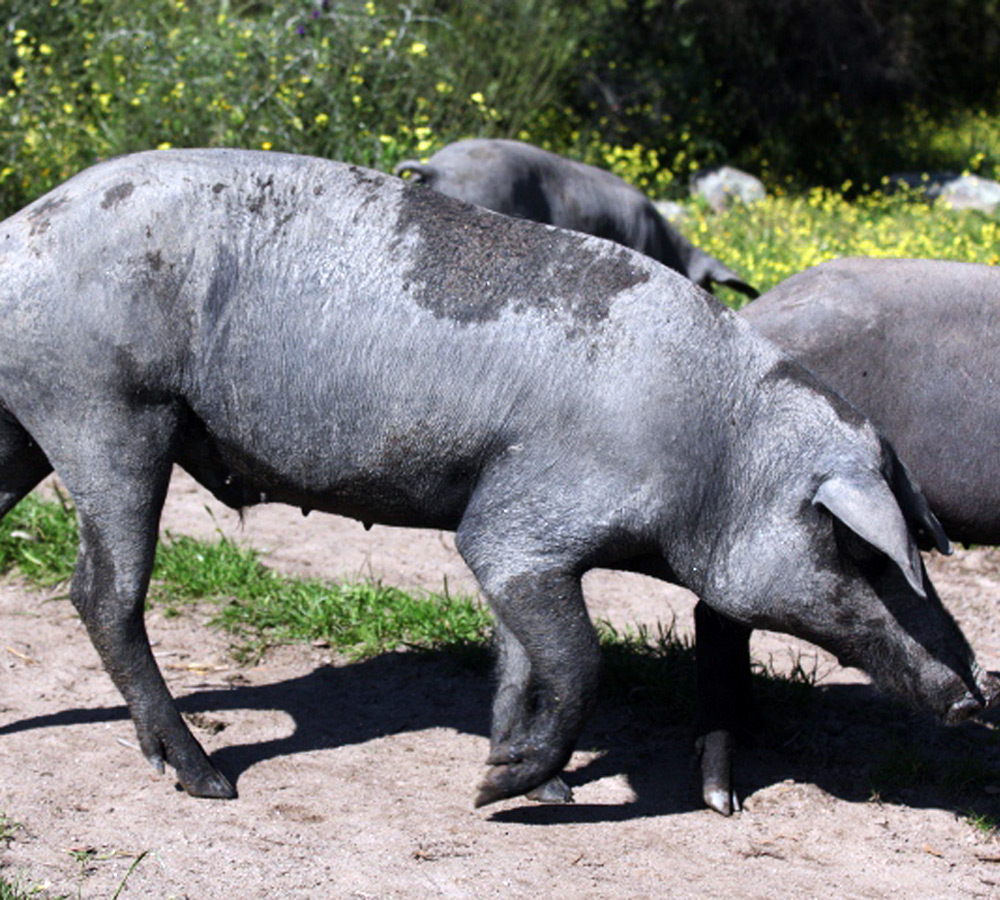
The black Lampiño pig is easily recognised by its lack of hair and the transverse folds on its forehead. It has great growth potential during the montanera period.
Origin / region:
It originates from the provinces of Cáceres, Badajoz and Córdoba.
Characteristics:
This breed is less early maturing and less developed than other varieties and shows a greater tendency to fattening. It is characterised by thin skin and either a complete absence of hair or sparse, fine hair, leaving many skin folds, particularly in the forehead region. The head is well proportioned, with a small forehead, broad, drooping ears, a distinctly elongated snout, sometimes with a white spot at its tip. The snout is prominent. The limbs are shorter, ranging from very thin to thick.
Colour:
The coat colour varies from deep black to a lighter slate shade.
The rare Lampiño variety is still found in Extremadura (provinces of Cáceres and Badajoz) and in Andalusia (province of Córdoba).
2 – The Entrepelado Black Pig
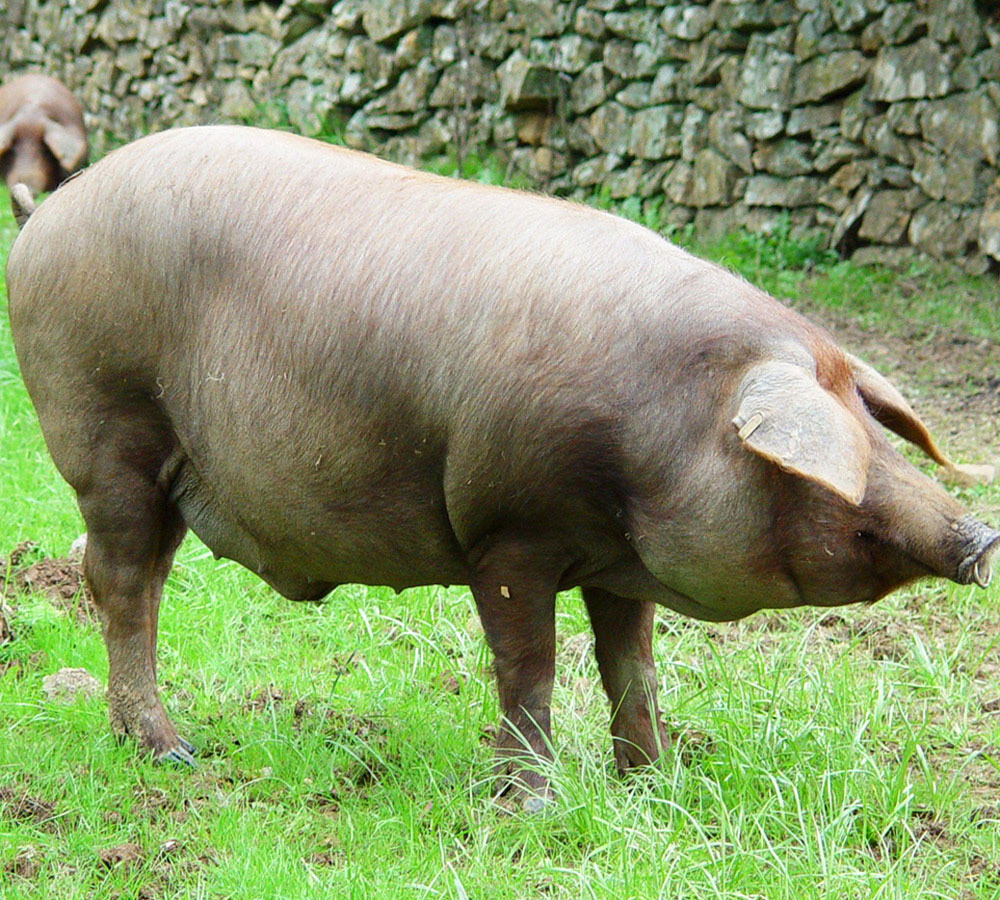
The Entrepelado black pig has a long frame and originates from crossbreeding between the Retinto and Lampiño strains. It shows intermediate characteristics, but carries less fat than the Lampiño.
Origin / Region:
Its origin lies in the mountains of Córdoba.
Characteristics:
This pig matures slightly earlier (grows relatively quickly) and is leaner than the Lampiño, though not as meaty as the Retinto. It stands out for its fine body conformation (carcass frame). The coat is sparse but denser along the dorsal side. The limbs are also slender.
Colour:
The skin at birth can be dark Retinto (dark reddish) or black. Adult pigs develop a deep, matte black colour.
The result is a handsome animal, with slender limbs, sparse coat, long snout and high-quality meat. It is the second most common variety after the Retinto and is mainly found in Salamanca, Cáceres, Badajoz, Seville, Huelva, and especially in the Sierra de Córdoba.
3 – The Retinto Pig
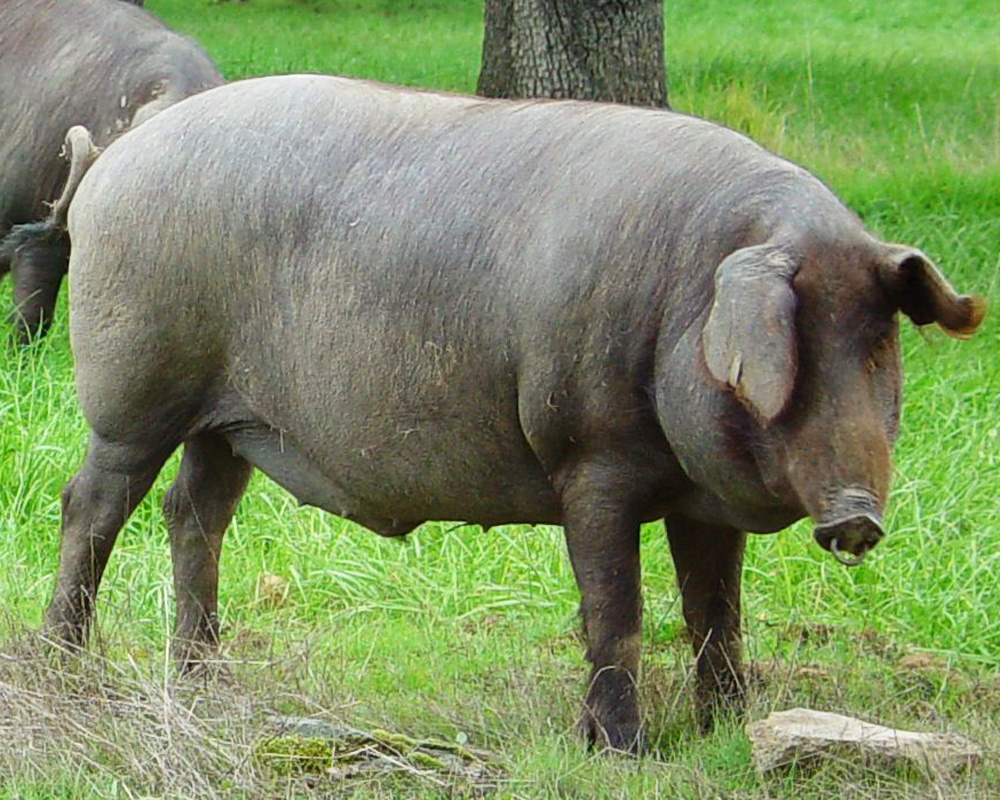
This is the most widespread variety due to its high productivity. Within the Retinto Iberian pig strain, several lineages exist. The "Retinto Extremadura" is the most common nowadays.
Origin / Region:
Traditionally found throughout southwestern Spain, from the south of Zamora to the Andalusian provinces of Cádiz and Málaga, and up to the centre of Toledo and Ciudad Real.
Characteristics:
Pigs of this strain always have hair of the same colour as their skin, evenly distributed over the body. They have a fine, light skeleton. The forehead is broad, snouts well proportioned, and the ears point forward and downward. The back tends to be straight, with well-developed loins. The legs are slender yet strong. Some specimens may have "mamellas"*.
Colour:
The coat ranges from lighter shades, similar to cinnamon, to the darker red hue known as "retinto", from which the breed gets its name. Its hallmark is indeed this uniform dark reddish colour, although variations may range from deep red to almost blond.
Today, it can be found in the Spanish provinces of Seville, Córdoba, Salamanca, Badajoz, Toledo, Cáceres, and Ciudad Real.
As the most representative variety of the current Iberian pig population, these pigs display the most standardised breed traits: medium-sized animals, light, active, easy to move, always with pigmented skin and sparse, fine hair. One of their standout features is the exceptional finesse of their limbs.
Note:
There is another lineage of Retinto Iberian pigs: the Portuguese one, with two types depending on coat colour—blond or retinto. Although the skin is always dark, the "Rubio" or "Ervideira" (in Portuguese) may show light streaks in the hooves (depigmentation), whereas the "Retinto" or "Caldeira" has a reddish coat and no depigmentation. This lineage has contributed significantly to the development of the major Spanish Retinto herds.
* Mamella: long, oval-shaped appendage found on the dewlap of certain animals, especially pigs and goats.
4 – The Torbiscal Pig
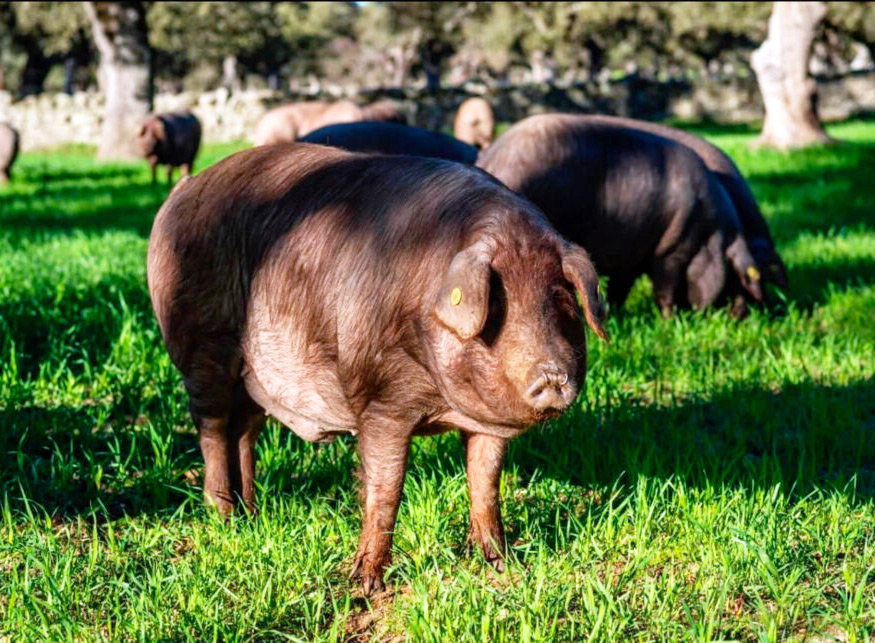
This is the youngest of the coloured varieties, the result of work carried out in the 1940s.
Origin / Region:
It was developed from the crossbreeding of four strains: the Portuguese Ervideira and Cardería, and the Spanish Campanario and Puebla. These were used to form the foundation herd in 1944 at "Dehesón del Encinar" in Oropesa (Toledo), using the purest and most characteristic Iberian pigs.
Characteristics:
These animals are larger than average, very resilient and more prolific due to the hybrid vigour of their ancestry. This variety has a thick coat. The head is distinctive with long ears and snout. The back is longer and straighter.
Colour:
The skin can range from light to slate grey, and the hooves may not have a uniform dark colour, often showing depigmented areas.
The Torbiscal Iberian pig line is also facing extinction: the light band on their hooves led many customers to doubt whether they were buying true "pata negra" Iberian ham. As a result, farmers gradually abandoned the breed, and it nearly disappeared, since customers often preferred other hams when they saw the depigmented strip. They did not consider it "authentic pata negra".
Today, the Torbiscal is found in Extremadura, Andalusia, Castilla-La Mancha and Castilla y León, especially near Córdoba, where one farm continues breeding females to preserve the lineage.
5 – The Manchado de Jabugo
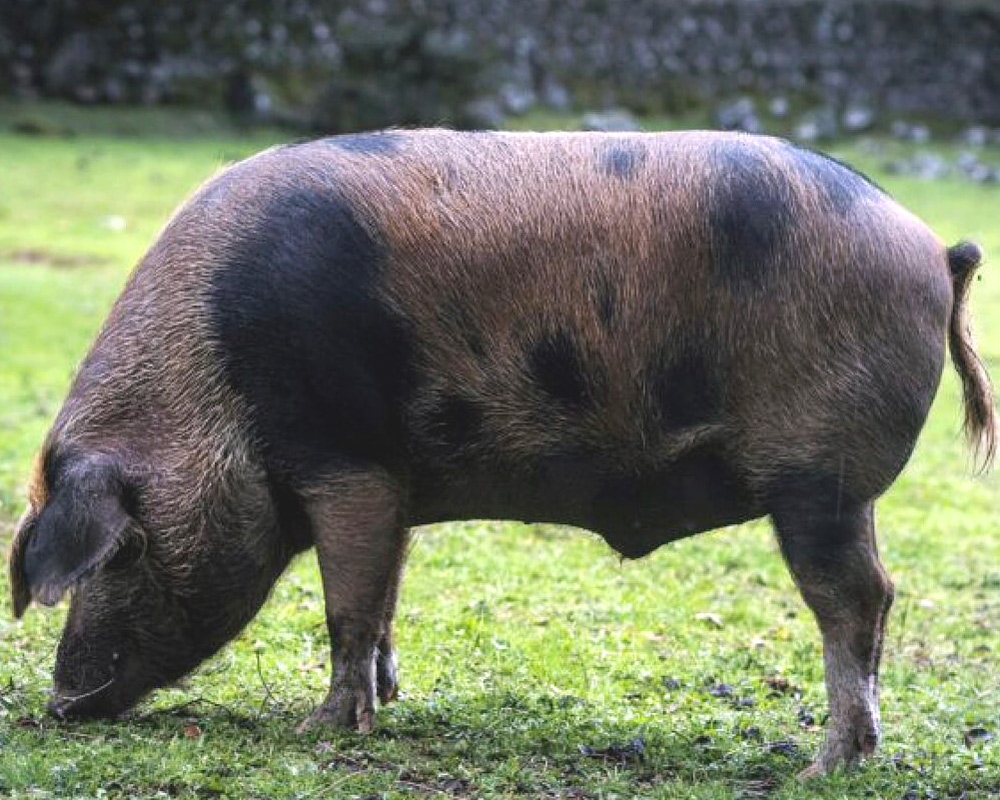
Also known simply as Jabugo, this breed is found in the Sierra de Huelva. It is easily recognisable by its blond coat with black or grey spots across the body.
Origin / Region:
It is believed to have originated in the 19th century through crosses between black Iberian pigs and red Iberian pigs. It is also thought that the pink Large White and Berkshire breeds contributed to the foundation of this population, which remained isolated for decades in certain villages of the Sierra de Aracena.
Characteristics:
The Manchado de Jabugo is unmistakable due to its unique colouring. It has a robust, well-proportioned body, slender yet sturdy legs adapted to the rugged terrain of the Huelva mountains. Traditional breeders highlight its exceptional ability to graze in difficult landscapes and make the most of pasture resources. Its medium-sized head, long snout, and forward-facing ears complete the profile of a pig unique among the Iberian varieties. The intramuscular fat infiltration, typical of all Iberian pigs, is especially pronounced in the Manchado, resulting in an exceptionally tender and smooth final product.
It nearly disappeared due to its lower productivity and hoof colour. Patience is required to enjoy a Manchado de Jabugo ham – it can take up to ten years from the pig’s birth to consumption. Additionally, litters are smaller and reproduce more slowly. Its hooves are not black, as is traditionally expected for acorn-fed Iberian ham, leading to its rejection under official standards. These factors contributed to its replacement by more productive varieties with better yields.
Colour:
Its skin tone ranges in shades of red, typically a reddish hue, and is dotted with black spots. This particular pigmentation is not only aesthetic but also plays an important role in the pig's adaptation to the local climate and resistance to environmental stressors.
This breed is renowned for its hardiness and ability to adapt to the harsh conditions of the dehesa. It feeds mainly on natural pastures and acorns during the "montanera" season, resulting in exceptionally flavourful and high-quality meat. The most expensive hams ever sold (as of 2025) come from this pig.
6 – The Andalusian "Rubio" Pig
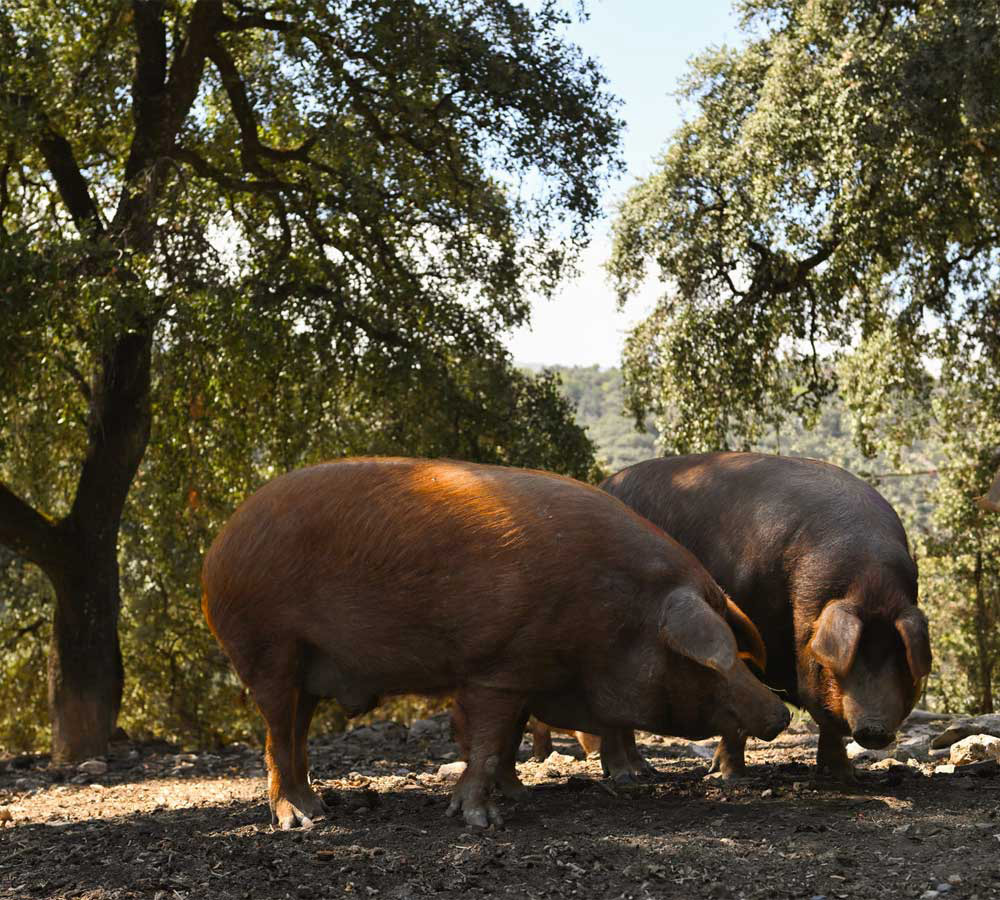
This pig has a much lighter coat than previous varieties – almost golden – making it easily recognisable. It is called "Andalusian" precisely because it is commonly found in that region.
Origin / Region:
It originates from the mountainous area surrounding Ronda, in the province of Málaga.
Characteristics:
These pigs have a blond, almost golden coat, silky and dense. They are small in size and well adapted to mountain pastures. Their legs are short and slim, yet muscular and developed. They also have a concave snout and very short ears. They require more food to reach the official Iberian weight standards. It takes nearly three years to raise them, making full use of all the resources offered by the dehesa.
Colour:
While the coat varies, it typically ranges from blond to golden shades.
These pigs are generally raised using the most traditional methods, roaming the pastures and feeding on acorns. This contributes significantly to the exceptional quality of the resulting meat.
Now virtually extinct, a few wild specimens have been found in the mountains of Ronda, living in complete freedom. This variety was on the verge of extinction but was recovered thanks to Finca La Algaba and Dehesa de Los Monteros, which managed to locate several specimens in the Serranía de Ronda.
This overview of the different varieties of Iberian pigs across the two main families reveals just how close some lineages came to extinction before being brought back due to trends, passion, or simple appreciation. We cannot list all endangered breeds here, but we’ll mention two more, linked to the production areas we work with:
The Black Pig of Los Pedroches:
The Los Pedroches Valley is a privileged area with around 300,000 hectares of holm oak dehesa. Unsurprisingly, it also has its own strain of black Iberian pig. These pigs were nearly lost, but thanks to tireless efforts by individuals, associations and institutions, disaster was avoided.
The Black Pig of Los Pedroches has a long body, drooping ears and decent growth rates. Studies carried out to support its recovery show that the breed is improving, offering slightly more meat yield and better growth vigour – both important traits for survival.
The "Dorado Gatidano":
This pig has a bright red-orange coat, thin limbs, and slow, rare development – likely due to high levels of inbreeding. Once officially declared extinct, local authorities in Cádiz captured wild specimens in the Tarifa countryside using cages. Some were transferred to endangered species recovery centres. This Iberian pig variety may soon be officially recognised again, once recovery is confirmed and the breed is re-entered into the official registry. Scientific studies by the University of Córdoba highlight its high levels of intramuscular "oleic acid" fat and a greater iron content, among other qualities.
The pink pigs (called "white pigs" in Spanish) are more numerous and diverse. Without going into detail here – which would be the subject of another article, this time linked to Serrano ham – we can mention: Hampshire, Landrace, Large White, Pietrain, Yorkshire, Berkshire, Duroc-Jersey. These breeds reach sexual maturity at 8 months, while Iberian pigs do so at around 5 months.
The myth of pig sweating:
Though the expression "to sweat like a pig" is common, the truth is that Iberian pigs cannot actually sweat – they lack sweat glands. To regulate their body temperature and protect themselves from the sun, pigs rely on water and mud.
The Iberian pig – regardless of its variety – roams freely in the dehesa, a typical ecosystem of southwestern Spain made up of oak trees and grasslands. It lives a semi-wild life, especially during the "montanera" season (October to February), when it feeds exclusively on acorns, grasses, and roots. This environment and slow diet favour the development of intramuscular fat that is melting, aromatic, and marbled. Hardy, resilient and perfectly adapted to this landscape, the Iberian pig has always been a key part of Mediterranean agro-silvo-pastoral tradition.
See also:
 fr
fr en
en es
es